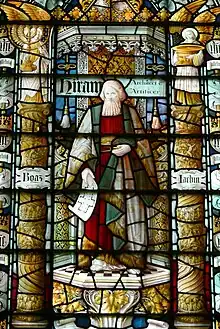1 Kings 7
1 Kings 7 is the seventh chapter of the Books of Kings in the Hebrew Bible or the First Book of Kings in the Old Testament of the Christian Bible.[1][2] The book is a compilation of various annals recording the acts of the kings of Israel and Judah by a Deuteronomic compiler in the seventh century BCE, with a supplement added in the sixth century BCE.[3] This chapter belongs to the section focusing on the reign of Solomon over the unified kingdom of Judah and Israel (1 Kings 1 to 11).[4] The focus of this chapter is the reign of Solomon, the king of Israel.[5]
| 1 Kings 7 | |
|---|---|
 The pages containing the Books of Kings (1 & 2 Kings) Leningrad Codex (1008 CE). | |
| Book | First book of Kings |
| Hebrew Bible part | Nevi'im |
| Order in the Hebrew part | 4 |
| Category | Former Prophets |
| Christian Bible part | Old Testament |
| Order in the Christian part | 11 |
Text
This chapter was originally written in the Hebrew language and since the 16th century is divided into 51 verses.
Textual witnesses
Some early manuscripts containing the text of this chapter in Hebrew are of the Masoretic Text tradition, which includes the Codex Cairensis (895), Aleppo Codex (10th century), and Codex Leningradensis (1008).[6] Fragments containing parts of this chapter in Hebrew were found among the Dead Sea Scrolls, that is, 4Q54 (4QKings; 50–25 BCE) with extant verses 20–21, 25–27, 29–42, 51.[7][8][9][10]
There is also a translation into Koine Greek known as the Septuagint, made in the last few centuries BCE. Extant ancient manuscripts of the Septuagint version include Codex Vaticanus (B; B; 4th century) and Codex Alexandrinus (A; A; 5th century).[11][lower-alpha 1]
Analysis
1 Kings 6 to 7 cover the building of the temple, with insertions of information about Solomon's palace, the "house of the forest of Lebanon", the hall of the throne, the hall of judgment, and a house for Pharaoh's daughter (1 Kings 7:1–12).[14]
Construction of the palace (7:1–12)
The temple was actually integrated into a larger complex of government buildings, by itself is comparable to a palace chapel.[15] Other buildings were larger and taken in all almost twice as long to build than the Temple alone (13 years vs. 7 years),[16] but seems to share similar architectural style and material.[15] The monumental 'House of the Forest of the Lebanon' was apparently named for its richly crafted and precious Lebanese timber, measuring roughly 50x25 meter with 45 pillars supporting the ceiling and partly an upper floor (perhaps functions as the royal bodyguard's armoury and quarters, cf. 1 Kings 10:17; Isaiah 22:8).[15]
Verse 4
- There were windows with beveled frames in three rows, and window was opposite window in three tiers.[17]
- "Windows" from Hebrew: שְׁקֻפִים, the same word as in 1 Kings 6:4 denoting "beams" or "lattices" ("beam layers" according to Keil; πλευρῶν in Septuagint).[18] They were arranged in "three rows" (or "tiers"), probably referring to 'three stories formed by the three rows of beams', so that the side chambers had 'their windows exactly vis-a-vis in each of the three stories' (as explained by Josephus: θυρώμασι τριγλύφοις, "windows in three divisions" in Ant., 7:05.2).[18]
The interior decoration of the Temple (7:13–51)

The big structures and furnishings in the temple of Solomon were crafted by a Phoenician craftsman called Hiram (or Ahiram), especially the two pillars which stood at the entrance to the temple (verses 15–22), and the circular bronze sea ("molten sea"; verses 23–26), among those listed in verses 40–47.[15] A note states that Solomon established his own ore-refinery in the Jordan valley to produce the necessary bronze material. [15] Other holy instruments and royal blessing-gifts were richly covered with gold (verses 48–51). [15]
Verses 13–14

- 13 And King Solomon sent and brought Hiram from Tyre.
- 14 He was the son of a widow of the tribe of Naphtali, and his father was a man of Tyre, a worker in bronze. And he was full of wisdom, understanding, and skill for making any work in bronze. He came to King Solomon and did all his work.[19]
- "Hiram from Tyre: called "Huram-abi" in 2 Chronicles 2:13, not to be confused with the Phoenician king in 1 Kings 5.[20] Spelled as "Hiram Abiff, he becomes the central character of an allegory presented to all candidates during the third degree in Freemasonry.[21]
Verse 21

- And he set up the pillars in the porch of the temple: and he set up the right pillar, and called the name thereof Jachin: and he set up the left pillar, and called the name thereof Boaz.[22]
These two pillars most likely were not support structures, but were free standing, based on similar pillars in other nearby contemporary temples.[23]
Verse 23


- And he made a molten sea, ten cubits from the one brim to the other: it was round all about, and his height was five cubits: and a line of thirty cubits did compass it round about.[24]
- Cross reference: 2 Chronicles 4:2
- "5 cubits": a length measurement of about 7.5 feet or 2.3 meters.[25]
- "30 cubits": about 45 feet or 14 meters.[26]
The approximation of the mathematical constant "π" ("pi"), defined as the ratio of a circle's circumference to its diameter, can apparently be calculated from this verse as 30 cubits divided by 10 cubits to yield "3". However, Matityahu Hacohen Munk observed that the spelling for "line" in Hebrew, normally written as קו qaw, in 1 Kings 7:23 is written (ketiv) as קוה qaweh. Using gematria, qaweh yields "111" whereas qaw yields "106", so when used in calculation it results in π = "3.1415094", very close to the modern definition of "3.1415926".[27][28] Charles Ryrie gives another explanation based on 1 Kings 7:26 (cf. 2 Chronicles 4:5) that the molten sea has a brim of a handbreadth (about 4 inches or 10 cm) wide, so when the inside diameter, subtracting 10 cubits (about 180 inches or 4.6 meter; from outer "brim to brim") with 2 times 4 inches (two handbreadth) to yield 172 inches (4.4 meter), is divided by π, it results in 540 inches (45 feet or 14 meter or 30 cubits) which is the circumference given in this verse.[29]
See also
- Related Bible parts: 2 Samuel 7, 1 Kings 5, 1 Kings 6, 2 Chronicles 3, 2 Chronicles 4
Notes
- The whole book of 1 Kings is missing from the extant Codex Sinaiticus.[12]
References
- Halley 1965, p. 191.
- Collins 2014, p. 288.
- McKane 1993, p. 324.
- Dietrich 2007, p. 234.
- Dietrich 2007, p. 236.
- Würthwein 1995, pp. 35–37.
- Ulrich 2010, pp. 324–327.
- Dead sea scrolls - 1 Kings
- Fitzmyer 2008, p. 35.
- 4Q54 at the Leon Levy Dead Sea Scrolls Digital Library
- Würthwein 1995, pp. 73–74.
-
 This article incorporates text from a publication now in the public domain: Herbermann, Charles, ed. (1913). "Codex Sinaiticus". Catholic Encyclopedia. New York: Robert Appleton Company.
This article incorporates text from a publication now in the public domain: Herbermann, Charles, ed. (1913). "Codex Sinaiticus". Catholic Encyclopedia. New York: Robert Appleton Company. - 1 Kings 7, Berean Study Bible
- Leithart 2006, p. 55.
- Dietrich 2007, p. 238.
- Coogan 2007, p. 501 Hebrew Bible.
- 1 Kings 7:4 NKJV
- Exell, Joseph S.; Spence-Jones, Henry Donald Maurice (Editors). On "1 Kings 7". In: The Pulpit Commentary. 23 volumes. First publication: 1890. Accessed 24 April 2019.
- 1 Kings 7:13–14 MEV
- Coogan 2007, p. 502 Hebrew Bible.
- Pietre Stones Kent Henderson, The Legend of Hiram Abif, retrieved 14 September 2012
- 1 Kings 7:21 KJV
- R. B. Y. Scott (1939). "The Pillars Jachin and Boaz". Journal of Biblical Literature. 58 (2): 143–149. doi:10.2307/3259857. JSTOR 3259857.
- 1 Kings 7:23 KJV
- Note [a] on 2 Chronicles 4:2 in MEV
- Note on 1 Kings 7:23 in MEV
- Missler, Chuck. The Value of Pi: Hidden Codes in the Bible. April 1, 1998. This finding was also reported by Shlomo Edward G. Belaga, in the page by Boaz Tsaban "Rabbinical Math" and in the book by Grant Jeffrey, "The Handwriting of God", Frontier Research Publications, Toronto Ontario, 1997.
- Munk, Matityahu Hacohen. Three Geometric Problems in the Bible and Talmud. Sinai 51 (1962), 218-227 (in Hebrew); Munk, Matityahu Hacohen. The Halachic Way in Solving Special Geometric Problems. Hadarom 27 (1968), 115-133 (in Hebrew). Cited i: Tsaban, Boaz; Garber, David. On the Rabbinical Approximation of Pi, Historia Mathematica 25 (1998), pp. 75-84.
- Ryrie, Charles (1986). Basic Theology. Wheaton, Illinois: SP Publications, p. 99.
Sources
- Collins, John J. (2014). "Chapter 14: 1 Kings 12 – 2 Kings 25". Introduction to the Hebrew Scriptures. Fortress Press. pp. 277–296. ISBN 978-1451469233.
- Coogan, Michael David (2007). Coogan, Michael David; Brettler, Marc Zvi; Newsom, Carol Ann; Perkins, Pheme (eds.). The New Oxford Annotated Bible with the Apocryphal/Deuterocanonical Books: New Revised Standard Version, Issue 48 (Augmented 3rd ed.). Oxford University Press. ISBN 978-0195288810.
- Dietrich, Walter (2007). "13. 1 and 2 Kings". In Barton, John; Muddiman, John (eds.). The Oxford Bible Commentary (first (paperback) ed.). Oxford University Press. pp. 232–266. ISBN 978-0199277186. Retrieved February 6, 2019.
- Fitzmyer, Joseph A. (2008). A Guide to the Dead Sea Scrolls and Related Literature. Grand Rapids, MI: William B. Eerdmans Publishing Company. ISBN 9780802862419.
- Halley, Henry H. (1965). Halley's Bible Handbook: an abbreviated Bible commentary (24th (revised) ed.). Zondervan Publishing House. ISBN 0-310-25720-4.
- Hayes, Christine (2015). Introduction to the Bible. Yale University Press. ISBN 978-0300188271.
- Leithart, Peter J. (2006). 1 & 2 Kings. Brazos Theological Commentary on the Bible. Brazos Press. ISBN 978-1587431258.
- McKane, William (1993). "Kings, Book of". In Metzger, Bruce M; Coogan, Michael D (eds.). The Oxford Companion to the Bible. Oxford University Press. pp. 409–413. ISBN 978-0195046458.
- Metzger, Bruce M; Coogan, Michael D, eds. (1993). The Oxford Companion to the Bible. Oxford University Press. ISBN 978-0195046458.
- Ulrich, Eugene, ed. (2010). The Biblical Qumran Scrolls: Transcriptions and Textual Variants. Brill.
- Würthwein, Ernst (1995). The Text of the Old Testament. Translated by Rhodes, Erroll F. Grand Rapids, MI: Wm. B. Eerdmans. ISBN 0-8028-0788-7. Retrieved January 26, 2019.
External links
- Jewish translations:
- Melachim I - I Kings - Chapter 7 (Judaica Press). Hebrew text and English translation [with Rashi's commentary] at Chabad.org
- Christian translations:
- Online Bible at GospelHall.org (ESV, KJV, Darby, American Standard Version, Bible in Basic English)
- 1 Kings chapter 7. Bible Gateway